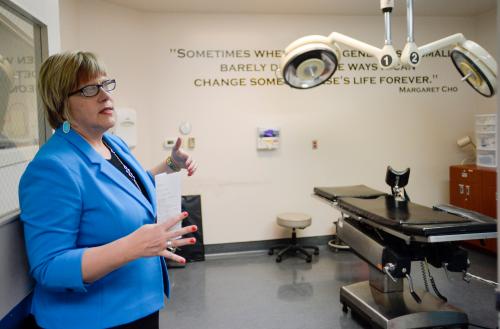The overturning of Roe v. Wade and this term’s Supreme Court abortion cases have understandably kept attention riveted on abortion. But while the abortion battle rages on, people are losing sight of the second front of the war to secure women’s reproductive autonomy: birth control.
As state abortion bans proliferate in the post-Roe era, the use of reliable birth control to prevent unintended pregnancies is more crucial than ever. Moreover, defenders of reproductive rights now must guard against an additional challenge—the offensive far-right conservatives are mounting against contraception.
Unplanned pregnancy is more common than most people realize. According to the latest data from the Centers for Disease Control (CDC), 42% of all pregnancies are unintended, meaning that the pregnancy was either unwanted or seriously mistimed.
While abortion is an important line of defense in preventing unplanned parenthood, it should be a last resort. The easiest way to prevent unplanned parenthood is to prevent an unintended pregnancy from occurring in the first place.
There are compelling reasons to support the use of effective birth control. A long and robust economic literature has shown that improving access to contraception reduces maternal morbidity and mortality. It also leads to healthier babies, less child poverty, better living circumstances for children, and improved educational and career opportunities for women.
In addition, birth control offers the most politically unifying approach to secure women’s reproductive autonomy. While just over one-third of the U.S. public doesn’t think abortion should be legal under any or most circumstances, nearly 9 in 10 approve the use of contraception, including 86% of Republicans. Birth control is also a more effective way to reduce abortion incidence than current state-level abortion bans which so far have not translated into fewer abortions nationwide. But if unplanned pregnancies essentially disappeared, there would be vanishingly few abortions.
And yet, despite birth control’s benefits and broad popularity, some conservatives are now targeting contraception.
Supreme Court Justice Clarence Thomas opened the door to these attacks when he argued that the same legal reasoning used to overturn Roe implies that “in future cases” the Court should “reconsider” Griswold v. Connecticut, the landmark case that established the Constitutional right to contraception in 1965. Since then, legislation to ban or restrict access to certain forms of contraception has already been discussed or proposed in Arkansas, Idaho, Louisiana, Michigan, and Missouri.
The Heritage Foundation as part of its Project 2025 initiative has called for a potential future Trump administration to restrict access to certain types of birth control. When asked about the topic in a recent TV interview, former President Trump said he was “looking at” policies that would restrict access, adding that “some states are going to have different policy than others.” He later walked back those comments, but many of Trump’s actions as president, including his decision to halve the patient capacity of the Title X program that provides affordable birth control and related services, foreshadow what may be his real intentions.
Senator Chuck Schumer recently led an effort to codify the right to contraception nationwide. All but two Senate Republicans present voted against the measure.
Central to Republicans’ attacks against contraception have been efforts by anti-abortion religious groups to falsely equate certain forms of birth control with abortion. That position is contrary to the consensus among medical experts that contraception, unlike abortion, does not terminate pregnancy and instead prevents pregnancy from occurring in the first place. The American College of Obstetricians and Gynecologists, for example, has stated: “None of the FDA-approved contraceptive methods are abortifacients because they do not interfere with a pregnancy and are not effective after a fertilized egg has implanted successfully in the uterus.”
Amid far-right attacks, defenders of women’s reproductive autonomy should focus more attention on effective contraception.
As a safe and virtually foolproof form of birth control, the surging popularity of long-acting reversible contraception (LARC) which includes IUDs and implants is especially promising. For a typical couple using a condom, the risk of pregnancy within five years is 63%. For those relying on the pill, it is 38%. With a LARC, it is less than 4%. LARCs change the default so that users can “set it and forget it” without losing sleep over concerns about getting pregnant.
Many women are taking notice. The share of women using LARCs increased sevenfold between 2002 and 2018. LARCs are now the third most common contraceptive method used by women after sterilization and the pill. Early evidence suggests more women and men are seeking out effective contraception including LARCs in response to the overturning of Roe v. Wade.
Beyond the increased use of LARCs, the first-ever over-the-counter birth control pill hit the shelves of major drug stores earlier this year. That is important because nearly one-third of women using the pill say they have missed taking their dosage because they were unable to get their next supply in time.
But what more could be done?
Primary care physicians should screen all women of reproductive age for their pregnancy intentions to encourage patients who don’t want to get pregnant to focus on the risks of sex and their contraceptive options for reducing them. We also need to ensure all healthcare providers, not just doctors, are trained in the use of LARCs, have them on hand, and can provide same day insertion. Where these approaches have been tried, unintended pregnancy and abortion rates have both declined dramatically.
In addition, more funding for Title X is needed. One rigorous study has shown that eliminating cost sharing for low-income patients seeking birth control would significantly reduce unintended pregnancies and abortions and save more than one billion dollars in Medicaid expenses in the first year alone.
The overturning of Roe v. Wade was a Pandora’s box that unleashed an invigorated assault on women’s fundamental freedoms. As the onslaught intensifies, defenders of women’s reproductive autonomy must fight back to fortify the first and strongest line of defense in protecting a woman’s right to choose if and when to seek a pregnancy.
-
Acknowledgements and disclosures
The Brookings Institution is financed through the support of a diverse array of foundations, corporations, governments, individuals, as well as an endowment. A list of donors can be found in our annual reports published online here. The findings, interpretations, and conclusions in this report are solely those of its author(s) and are not influenced by any donation.








Commentary
Op-edExpanding access to birth control is the surest way to defend women’s right to choose
July 30, 2024